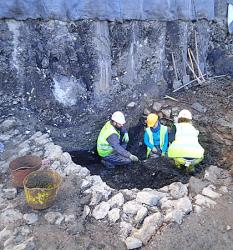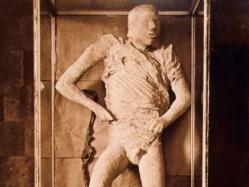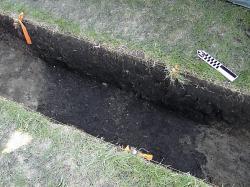INSTITUT SUPERIEUR D'ANTHROPOLOGIE
INSTITUTE OF ANTHROPOLOGY
ONLINE COURSES / COURS A DISTANCE
SUMMER TERM : JULY 2014
REGISTER NOW
ROYAUME UNI –  Edinburgh - A boundary ditch which intersected an area of Edinburgh for 200 years is one of the rediscoveries in a dig revealing medieval living.Pots from ancient Europe, bronze pins, coins from across history, clay pipes and animal bones are expected to portray 800 years of life after being discovered during an archaeological dig as part of a £65.7 million development within the Scottish capital’s World Heritage Site. Archaeologists hope to use soil samples from Canongate to deduce the plants and fruits eaten by medieval people. They say animal hide tanning was the main industrial process taking place at the backlands – gardens and industrial settings behind homes – off Holyrood Road hundreds of years ago. “We knew the site could help us understand how the Canongate developed from its origins in the 12th century to become the site of an important Victorian brewery,” said John Lawson, the City of Edinburgh Council’s Archaeology Officer, surveying the results of a dig which will ultimately create student accommodation. “It was important to discover what this area had to tell us about the history of our city before allowing a new development to emerge on the site. “But we were surprised to find over four metres of preserved architectural remains and rare survivals of materials. “The site has revealed the first evidence of an industrial-scale tanning industry in Edinburgh and also provides vital information on the topography of Edinburgh. “The survey has also helped to pinpoint the location of the boundary ditch that existed between Edinburgh and the Canongate for over 200 years.”
Edinburgh - A boundary ditch which intersected an area of Edinburgh for 200 years is one of the rediscoveries in a dig revealing medieval living.Pots from ancient Europe, bronze pins, coins from across history, clay pipes and animal bones are expected to portray 800 years of life after being discovered during an archaeological dig as part of a £65.7 million development within the Scottish capital’s World Heritage Site. Archaeologists hope to use soil samples from Canongate to deduce the plants and fruits eaten by medieval people. They say animal hide tanning was the main industrial process taking place at the backlands – gardens and industrial settings behind homes – off Holyrood Road hundreds of years ago. “We knew the site could help us understand how the Canongate developed from its origins in the 12th century to become the site of an important Victorian brewery,” said John Lawson, the City of Edinburgh Council’s Archaeology Officer, surveying the results of a dig which will ultimately create student accommodation. “It was important to discover what this area had to tell us about the history of our city before allowing a new development to emerge on the site. “But we were surprised to find over four metres of preserved architectural remains and rare survivals of materials. “The site has revealed the first evidence of an industrial-scale tanning industry in Edinburgh and also provides vital information on the topography of Edinburgh. “The survey has also helped to pinpoint the location of the boundary ditch that existed between Edinburgh and the Canongate for over 200 years.”
http://www.culture24.org.uk/history-and-heritage/archaeology/art482725-Medieval-animal-hide-%20tanning-architecture-and-ditch-revealed-archaeologists-Edinburgh
CHILI –  El Laucho - A group of students discovered a 7,000-year-old mummy in northern Chile, the media reported on Monday. The mummy was found in El Laucho beach at the foothills of Morro de Arica, La Tercera newspaper reported, according to Xinhua. The students were part of an archaeology workshop and were investigating the site of a landslide caused by the 8.2-magnitude earthquake that hit the region April 1. The students from the Escuela America school were performing an excavation when they found the mummy. The mummy belongs to the Chinchorro culture and has an estimated age of 7,000 years. Authorities from the Chilean National Heritage Office arrived at the site to investigate the remains.:Chinchorro culture consists of fishermen villages located in the coast of Atacama desert, from Ilo in Peru in the north to Antofagasta in the south between 7020 BC and 1500 BC.
El Laucho - A group of students discovered a 7,000-year-old mummy in northern Chile, the media reported on Monday. The mummy was found in El Laucho beach at the foothills of Morro de Arica, La Tercera newspaper reported, according to Xinhua. The students were part of an archaeology workshop and were investigating the site of a landslide caused by the 8.2-magnitude earthquake that hit the region April 1. The students from the Escuela America school were performing an excavation when they found the mummy. The mummy belongs to the Chinchorro culture and has an estimated age of 7,000 years. Authorities from the Chilean National Heritage Office arrived at the site to investigate the remains.:Chinchorro culture consists of fishermen villages located in the coast of Atacama desert, from Ilo in Peru in the north to Antofagasta in the south between 7020 BC and 1500 BC.
http://economictimes.indiatimes.com/industry/et-cetera/students-discover-7000-year-old-mummy-in-chile/articleshow/35625762.cms
SOMALILAND –  - Somaliland is endowed with a great wealth of rock arts, which spots a "buried treasures" and surrounding by powerful surprises. Protecting culture under attack, "destroying culture hurts society for the long term.Somaliland Neolithic is oldest and the most testified records on earth of human thought in the recorded history, it shows vary imagines of human imaginations, its surprise gift left behind by our ancestors and irreplaceable and can't exchange with a face value. Somaliland archaeology is linage indicator between Israel and Somaliland common heritage and it's a gift, precious gift left behind by our ancestors, which can bring to their people together with pride, wealth and common commitment to share it and preserve it.
- Somaliland is endowed with a great wealth of rock arts, which spots a "buried treasures" and surrounding by powerful surprises. Protecting culture under attack, "destroying culture hurts society for the long term.Somaliland Neolithic is oldest and the most testified records on earth of human thought in the recorded history, it shows vary imagines of human imaginations, its surprise gift left behind by our ancestors and irreplaceable and can't exchange with a face value. Somaliland archaeology is linage indicator between Israel and Somaliland common heritage and it's a gift, precious gift left behind by our ancestors, which can bring to their people together with pride, wealth and common commitment to share it and preserve it.
http://somalilandsun.com/index.php?option=com_content&view=article&id=5816:somaliland-sum-of-all-threats-in-mass-destructions-of-national-heritage&catid=28:opinion
USA –  Wood Lake - As the final battle of the U.S.-Dakota War of 1862 raged about them, soldiers with Minnesota's 3rd Regiment just returned from fighting the Confederates stood ready in a trench to protect the camp Colonel Henry Sibley had made on the open prairie. Last week, a portion of that defensive trench reappeared on the prairie. Michelle Terrell, an archaeologist with Two Pines Resource Group of Shafer and co-workers excavated a portion of the 30-meter-long rifle pit at the site of the Wood Lake Monument in eastern Yellow Medicine County. Still, the campsite can help tell a great deal about that history, according to Terrell. Her recent work showed that the site had not been significantly disturbed since 1862. That's despite the fact that the area had once been a homestead and work had occurred to erect the obelisk.
Wood Lake - As the final battle of the U.S.-Dakota War of 1862 raged about them, soldiers with Minnesota's 3rd Regiment just returned from fighting the Confederates stood ready in a trench to protect the camp Colonel Henry Sibley had made on the open prairie. Last week, a portion of that defensive trench reappeared on the prairie. Michelle Terrell, an archaeologist with Two Pines Resource Group of Shafer and co-workers excavated a portion of the 30-meter-long rifle pit at the site of the Wood Lake Monument in eastern Yellow Medicine County. Still, the campsite can help tell a great deal about that history, according to Terrell. Her recent work showed that the site had not been significantly disturbed since 1862. That's despite the fact that the area had once been a homestead and work had occurred to erect the obelisk.
http://www.twincities.com/localnews/ci_25842540/minnesota-rifle-pit-from-u-s-dakota-war?